ChangeThis
The original idea behind ChangeThis came from Seth Godin, and was built in the summer of 2004 by Amit Gupta, Catherine Hickey, Noah Weiss, Phoebe Espiritu, and Michelle Sriwongtong. In the summer of 2005, ChangeThis was turned over to 800-CEO-READ. In addition to selling and writing about books, they kept ChangeThis up and running as a standalone website for 14 years. In 2019, 800-CEO-READ became Porchlight, and we pulled ChangeThis together with the rest of our editorial content under the website you see now. We remain committed to the high-design quality and independent spirit of the original team that brought ChangeThis into the world.
-
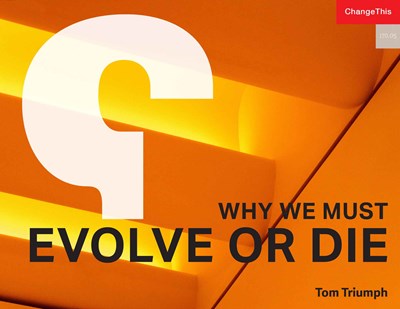
Blog / ChangeThis
Why We Must Evolve, or Die
By Tom Triumph
"Change means doing things that are new, and forgoing things that are familiar. It means discomfort and uncertainty, and the real likelihood of being wrong. All in all, it's scary. It really comes down to a decision. You either ride things out, fight for the status quo and hope the changes you're sensing are going to slow (they won't), or you think about where the world is headed and change to get yourself there. The journey is difficult, but the direction is clear. Evolve or die."
Categories: changethis
-

Blog / ChangeThis
Playing Fair While Creating and Unfair Advantage
By Anthony Iannarino
"For most of us in sales, winning new business often means taking that business away from a competitor. The euphemism we use to describe stealing a client from a competitor is called 'a competitive displacement,' which sounds a lot nicer than 'eating their lunch. ' However, if this sounds harsh, know that while you are trying to take clients from your competitors, they are trying to steal your clients from you. Like other forms of competition, selling requires a sense of fairness, a set of ethics, ground rules, if you will. Certain behaviors are off limits, like lying about your competitor, talking bad about them, providing kickbacks, or misleading people into believing something that isn't true as it pertains to about how you can better serve them. These dirty tricks are off limits, and they aren't how you gain a real advantage. That said, there are ways you can create an unfair advantage and position yourself to win new clients that are presently being served by your competition. ".
Categories: changethis
-
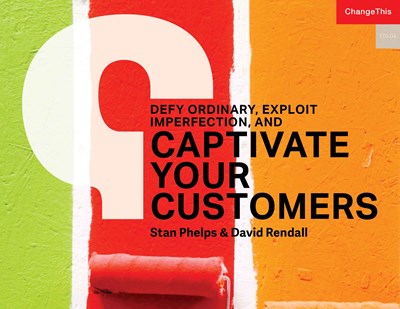
Blog / ChangeThis
Defy Ordinary, Exploit Imperfection, and Captivate your Customers
By Stan Phelps, David Rendall
"It's very common for brands to homogenize. As we look at what successful companies are doing, it's natural to emulate them. This has even been institutionalized in the process of benchmarking. We try to find out what others are doing right, and then do the same thing. It sounds reasonable, but there's a problem. The problem is that when everyone in an industry starts copying the leaders, then, over time, the entire industry starts to look the same, feel the same, and sound the same. There are no differences. Nothing distinguishes one brand from another."
Categories: changethis
-
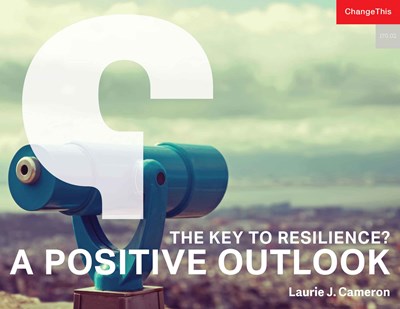
Blog / ChangeThis
The Key to Resilience? A Positive Outlook
By Laurie J. Cameron
"Researchers find that people who are resilient tend to be more positive and optimistic compared to those who are less-resilient. They are better able to regulate their emotions. And they are able to maintain their optimism through the most challenging situations. Resilience, a positive outlook, and optimism are connected. So, is having a positive outlook something you are born with, or can it be developed. Good news. A positive outlook can be cultivated with mindfulness. You can learn to choose your mindset and to shift how you relate to your experience, so that you have less stress and more joy. Mindfulness is a capacity that allows you to deliberately direct your attention towards the positive instead of being tossed around by random thoughts and turbulent emotions. What we see in stories of positive outlook and resilience is that the protagonists learn to 'choose their story'—they develop the skill of directing their attention to the positive and making meaning of what happens by filtering through a positive lens.
Categories: changethis
-
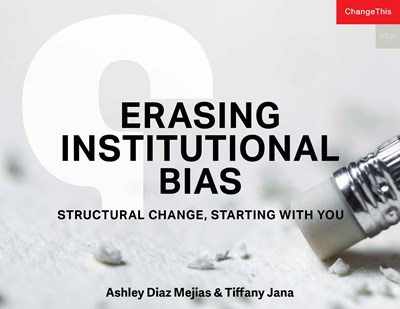
Blog / ChangeThis
Erasing Institutional Bias: Structural Change, Starting with You
By Tiffany Jana, Ashley Diaz Mejias
"Many organizational leaders long to talk about diversity and inclusion, and want to make diverse hires and bring more people into the room. But institutionalized biases have put true equity—the breaking up of the dominance of one culture and the creation of space for those who have been underrepresented—out of reach for those who are working towards creating more just workspaces. In our work with organizations, we have found that erasing institutional bias is a difficult task. When bias is operating at a systems level, it can seem impossible to change. But with humility, patience, and some tools, change is possible. Working against institutional bias, as we will explain, involves more than just increasing simple numbers. It includes the hard and often vulnerable work of making room at the table, on the board, and in the c-suite for those who have not historically been represented. It requires undoing our cultural assumptions about what bias is and how it works, and then giving ourselves over to the introspective and collective work of erasing institutional bias.
Categories: changethis
-
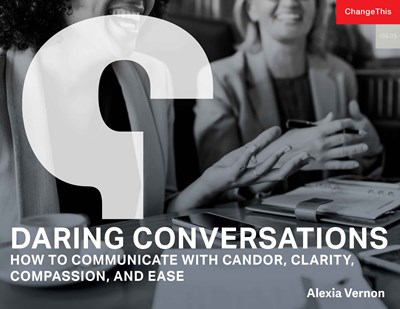
Blog / ChangeThis
Daring Conversations: How to Communicate with Candor, Clarity, Compassion, and Ease
By Alexia Vernon
"There is no shortage of theories about why there are not more women leading companies, boards, and local, state, and national governments. Explanations range from the persistence of the glass ceiling, inflexible work-life policies, male-dominated networks, and unconscious gender bias. As a result, solutions for correcting the lack of gender parity typically include remedying workplace policies and practices that privilege men and penalize women—or sponsoring women to attend women's leadership conferences, professional development training, and mentorship programs. And while all of these solutions have merit, what remains lacking is a complementary intervention that addresses a behavior most women struggle with—a behavior that leaders irrespective of gender need to possess. For the last decade, I've supported women to step into their moxie—what I define as possessing the mindset and skillset to be able to walk into any room, or onto any stage, and speak up for yourself and the ideas and issues that matter most to you (and to your company).
Categories: changethis
-
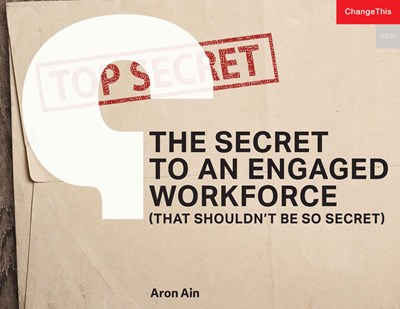
Blog / ChangeThis
The Secret to an Engaged Workforce (That Shouldn't Be So Secret)
By Aron Ain
"Do you want your employees to absolutely love coming to work. Employees who love their work put in their best effort and perform better. They work better in teams. They feel more loyalty toward the company. They stay in their jobs longer. They help you recruit top talent. They come to you with new ideas. And, they make your company stronger. You know all this, which is why you're already working hard to pump up that all-important employee engagement metric. You're paying competitive salaries and benefits. You're offering attractive career paths. You're providing a whole array of attractive perks—social outings, free food, yoga classes, a swank office, flexible hours, the latest technology, maybe even a masseuse on premises. With all this, you think, why would talented employees possibly wish to go anywhere else. There is a reason, one that you might have overlooked. . . . You see, employees might join companies because of the money, the perks, or the company's brand, but they leave companies because of their managers.
Categories: changethis
-
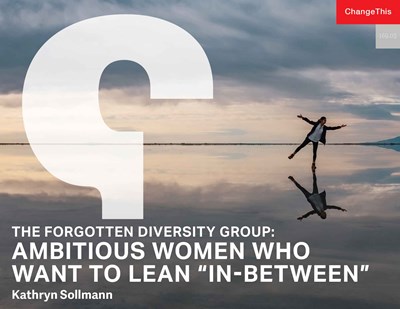
Blog / ChangeThis
The Forgotten Diversity Group: Ambitious Women Who Want to Lean "In-Between"
By Kathryn Sollmann
"Diversity and inclusion is a hot topic on corporate agendas these days, but despite the best efforts of employers, a large group of women are feeling left out. When it comes to leadership training, employers are still pressuring women to conform to one profile of an ambitious and successful woman. In the last decade, I've coached thousands of women who feel like they're letting down the power sisterhood if they don't do their part to break the glass ceiling. These women in the everyday sisterhood are smart, capable and ambitious—but they want alternate routes to 'grow in place' while family pressures are high. When I speak to women's groups, my message is that 'Up is Not the Only Way Forward.' To prevent women from taking costly caregiving breaks, and to retain great talent, employers need to make room for many brands of ambition and success."
Categories: changethis
-
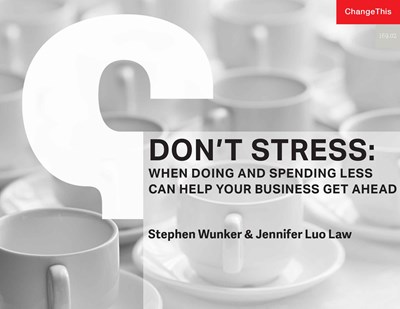
Blog / ChangeThis
Don't Stress: When Doing and Spending Less Can Help Your Business Get Ahead
By Stephen Wunker, Jennifer Luo Law
"As a result of our fascination with the latest and the greatest, the word 'innovation' is often used as a synonym for technological advancement, bringing with it imagination-capturing glory—as well as its less savory reputation for being expensive and fickle. But that's just one dimension of innovation. In our combined decades of experience working in this field, we've seen that there are many ways to innovate that don't take as much time, or require as much money and investment, as a moonshot initiative. And they're less overwhelming to get started with, to boot. Innovation doesn't always have to be more—more flavors, more horsepower, more memory space, more bells and whistles. In some cases, customers don't want more. They just want us to do the job they've hired us to do, and for us to do it very, very well. New solutions can excel in their simplicity, earning customer love and saving money along the way—and, yes, that is just as deserving of being called 'innovative' as a new blockchain game or genetic therapy.
Categories: changethis
-
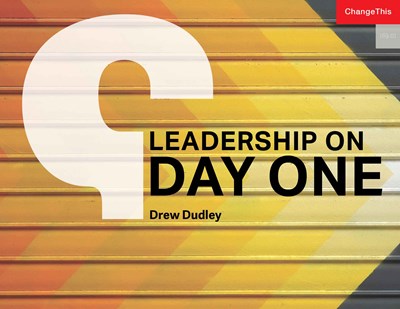
Blog / ChangeThis
Leadership On Day One
By Drew Dudley
"I've studied leadership my entire adult life, and I firmly believe there is no shortage of leadership on this planet. However, we are systematically ignoring a huge percentage of the leadership that surrounds us each day because we have chosen to define it too narrowly. To change that we need to teach a more accessible form of leadership: one that acknowledges that while not everyone can or should be a CEO or senior executive, there is a form of leadership to which we all can and should aspire. My goal is to make living that form of leadership more accessible and appealing (and as such, spread it throughout our organizations and communities) by providing a clear place to start: Day One."
Categories: changethis

